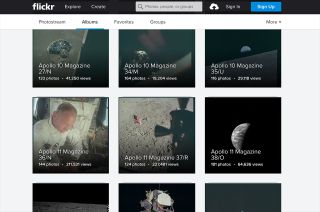Apollo Photos Redux: The Story Behind the NASA Moon Pics Posted to Flickr

The addition of tens of thousands of the Apollo astronauts' moon photos to an online repository drew worldwide media interest this week, but lost in many of the headlines were the facts behind the four-decade-old photographs.
Numerous news articles declared the photos were "never before seen" and attributed the upload to NASA, neither of which were true. The images were described as "new" and "secret" and "restored," when, in fact, they are old, public and untouched.
"Contrary to some recent media reports, this Flickr gallery is not a NASA undertaking, but an independent one," said Kipp Teague, the founder of the Project Apollo Archive, in an introduction he wrote for the newly-added gallery. "[This is] a re-presentation of the public domain, NASA-provided Apollo mission imagery as it was originally provided in its raw, high-resolution and unprocessed form." [NASA's 17 Apollo Moon Missions in Pictures]
For 15 years, Teague's Project Apollo Archive website has been presenting and organizing the photographs taken by astronauts during the 11 Apollo missions, including the six that successfully landed on the moon between July 1969 and December 1972. Those photos include iconic images, such as the shot first moonwalker Neil Armstrong took of Buzz Aldrin standing at Tranquility Base, as well the more seldom seen imagery of landscapes and hardware.
Initially, the photographs on Teague's website were NASA-provided scans made from "master dupes" – duplicates of the film used in the astronauts' Hasselblad cameras. But in 2004, Teague began adding images based on the scans taken directly from the 70mm film magazines, or rolls, as received from NASA's Johnson Space Center in Houston.
"The process involves removing each original [flown] film roll from a double-freezer, allowing it to thaw, then digitally scanning each frame using a long roll film scanner," wrote Teague in 2004, describing how the scans were produced.
These scans were scaled down and color-corrected before they appeared on the Archive.
Get the Space.com Newsletter
Breaking space news, the latest updates on rocket launches, skywatching events and more!
In the decade that followed, users of Teague's site and the Apollo Lunar Surface Journal, another independent project documenting the astronauts' activities on the moon, have made requests for an improved presentation of the gallery, as well as asked about the photos' original resolution and the processing that had been applied to the scans.
Those requests led to Teague uploading the full-resolution, unprocessed scans to Flickr.
As the media caught attention of the new gallery though, the story behind the photos — and about Teague, himself — began to spin out of control.
"In one article I was described as an employee of Johnson Space Center, and in another, the headline indicated that a 'NASA astronaut' had uploaded the images," Teague told collectSPACE in an email. "My role has at most been as a volunteer working with the NASA History Office from my home in Virginia, and alongside Eric Jones in support of his 'bible' of the Apollo missions, the Apollo Lunar Surface Journal."
Teague began the upload process in late-September with the addition of two magazines of photos. By the time he is finished later this month, he expects the gallery to present at least 13,000 images. [Apollo Quiz: Test Your Moon Landing Memory]
But none of the photos are new or have never before been seen, said Teague.
"I do not believe any of these images are actually new to the public, as all have been available over the years by one means or another," he said. "The grand majority have been available online in one format or another."
That is not to suggest that the Project Apollo Archive Flickr Gallery doesn't deserve to be celebrated in the media and elsewhere.

The availability of the full-resolution scans has already led to enthusiasts stitching together collections of the photos to create new panoramas and animations. Teague has set up a new Facebook page where he plans to occasionally share newly-rendered versions of the Apollo imagery.
In addition to Teague's efforts to make the raw Hasselblad photos accessible, Arizona State University partnered with NASA in 2007 to digitally scan all of the original film from the Apollo moon missions, focusing primarily on the larger format film used in lunar orbit. That project has produced and put online more than 10,000 metric and almost 5,000 panoramic frames.
Watch a stop-motion animation created from hundreds of the images in the new Project Apollo Archive Flickr gallery at collectSPACE.
Follow collectSPACE.com on Facebook and on Twitter at @collectSPACE. Copyright 2015 collectSPACE.com. All rights reserved.
Join our Space Forums to keep talking space on the latest missions, night sky and more! And if you have a news tip, correction or comment, let us know at: community@space.com.

Robert Pearlman is a space historian, journalist and the founder and editor of collectSPACE.com, an online publication and community devoted to space history with a particular focus on how and where space exploration intersects with pop culture. Pearlman is also a contributing writer for Space.com and co-author of "Space Stations: The Art, Science, and Reality of Working in Space” published by Smithsonian Books in 2018. He previously developed online content for the National Space Society and Apollo 11 moonwalker Buzz Aldrin, helped establish the space tourism company Space Adventures and currently serves on the History Committee of the American Astronautical Society, the advisory committee for The Mars Generation and leadership board of For All Moonkind. In 2009, he was inducted into the U.S. Space Camp Hall of Fame in Huntsville, Alabama. In 2021, he was honored by the American Astronautical Society with the Ordway Award for Sustained Excellence in Spaceflight History.

